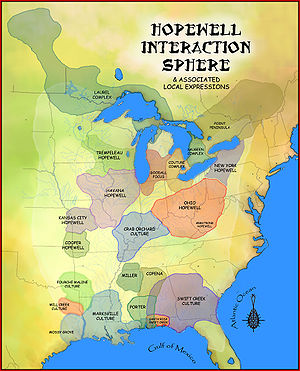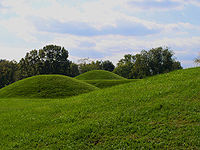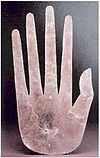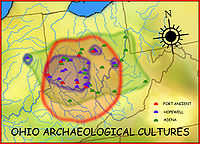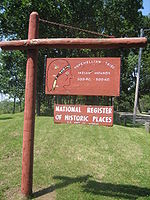- Hopewell tradition
-
The Hopewell tradition (also incorrectly called the "Hopewell culture"[citation needed]) is the term used to describe common aspects of the Native American culture that flourished along rivers in the northeastern and midwestern United States from 200 BCE to 500 CE. The Hopewell tradition was not a single culture or society, but a widely dispersed set of related populations. They were connected by a common network of trade routes,[1] known as the Hopewell Exchange System. At its greatest extent, the Hopewell exchange system ran from the Southeastern United States into the southeastern Canadian shores of Lake Ontario. Within this area societies participated in a high degree of exchange with the highest amount of activity along waterways. The Hopewell exchange system received materials from all over the United States. Most of the items traded were exotic materials and were received by people living in the major trading and manufacturing areas. These people then converted the materials into products and exported them through local and regional exchange networks. The objects created by the Hopewell exchange system spread far and wide and have been seen in many burials outside the Midwest.[2]
Origins
Although the origins of the Hopewell are still under discussion, the Hopewell culture can also be considered a cultural climax.
Hopewell populations originated in western New York and moved south into Ohio where they built upon the local Adena mortuary tradition. Or Hopewell was said to have originated in western Illinois and spread by diffusion ... to southern Ohio. Similarly, the Havana Hopewell tradition was thought to have spread up the Illinois River and into southwestern Michigan, spawning Goodall Hopewell. (Dancey 114)
The name "Hopewell" was applied by Warren K. Moorehead after his explorations of the Hopewell Mound Group in Ross County, Ohio in 1891 and 1892. The mound group itself was named for the family that owned the earthworks at the time. It is unknown what any of the various groups now defined as Hopewellian called themselves.[3][4]
Politics and hierarchy
The Hopewell inherited from their Adena forebearers an incipient social stratification. This increased social stability and reinforced sedentism, social stratification, specialized use of resources and probably, population growth.[5] Hopewell societies cremated most of their deceased and reserved burial for only the most important people. In some sites, it appears that hunters received a higher status in the community because their graves were more elaborate and contained more status goods.[6]
The Hopewellian peoples had leaders, but they were not like powerful rulers who could command armies of slaves and soldiers.[3] It is likely these cultures accorded certain families a special place of privilege. Some scholars suggest that these societies were marked by the emergence of “big-men”.[7] These leaders acquired their position because of their ability to persuade others to agree with them on important matters such as trade and religion. They also perhaps were able to develop influence by the creation of reciprocal obligations with other important members of the community. Whatever the source of their status and power, the emergence of “big-men” was another step toward the development of the highly structured and stratified sociopolitical organization called the chiefdom.[6]
Mounds
Today, the best-surviving features of the Hopewell Tradition era are mounds built for uncertain purposes. Great geometric earthworks are one of the most impressive Native American monuments throughout American prehistory. Eastern Woodlands mounds have various geometric shapes and rise to impressive heights. The function of the mounds is still under debate. Due to considerable evidence and surveys, plus the good survival condition of the largest mounds, more information can be obtained.
Several scientists, including Dr. Bradley T. Lepper, Curator of Archaeology, Ohio Historical Society, hypothesize that the Octagon earthwork at Newark, Ohio, was a lunar observatory oriented to the 18.6 year cycle of minimum and maximum lunar risings and settings on the local horizon. Dr. John Eddy completed an unpublished survey in 1978, and proposed a lunar major alignment for the Octagon. Ray Hively and Robert Horn of Earlham College in Richmond, Indiana were the first researchers to analyze numerous lunar sightlines at the Newark Earthworks (1982) and the High Banks Works (1984) in Chillicothe, Ohio.[8] Christopher Turner noted that the Fairground Circle in Newark, Ohio aligns to the sunrise on May 4, i.e. that it marked the May cross-quarter sunrise.[9] In 1983, Christopher Turner demonstrated that the Hopeton Earthworks encode various sunrise and moonrise patterns, including the winter and summer solstices, the equinoxes, the cross-quarter days, the lunar maximum events, and the lunar minimum events.[10]
William F. Romain has written a book on the subject of "astronomers, geometers, and magicians" at the earthworks.[11]
Many of the mounds also contain various types of burials.
Artwork
The Hopewell created some of the finest craftwork and artwork of the Americas. Most of their works had some religious significance, and their graves were filled with necklaces, ornate carvings made from bone or wood, decorated ceremonial pottery, ear plugs, and pendants. Some graves were lined with woven mats, mica (a flaky clear mineral), or stones.[12] The Hopewell produced artwork in a greater variety and with more exotic materials than their predecessors the Adena. Grizzly bear teeth, fresh water pearls, sea shells, sharks' teeth, copper and even small quantities of silver were turned into beautifully crafted pieces. The Hopewell artisans were expert carvers of pipestone, and many of the mortuary mounds are full of exquisitely carved statues and pipes.[13] The Mound of Pipes at Mound City produced over 200 stone smoking pipes depicting animals and birds in well-realized three-dimensional form,[14] and the Tremper Site in Scioto County produced over 130.[15] Some artwork went beyond the ordinary exotic, as Hopewell artists were expert carvers of human bone. A rare mask from Mound City was created using a human skull as a face plate.[16] Hopewell artists created both abstract and realistic portrayals of the human form. One tubular pipe is so realistically portrayed that we can tell the model was an achondroplastic (chondrodystropic) dwarf.[17] Many other figurines give us details of dress, ornamentation, and hairstyles.[16] An example of their abstract human forms is the "Mica Hand" from the Hopewell Site in Ross Co., Ohio. Delicately cut from a piece of mica, more than 11 inches long and 6 inches wide, the hand piece was likely worn or carried for public viewing.[18]
Local expressions of Hopewellian traditions
Aside from the more famous Ohio Hopewell, a number of other Middle Woodland period cultures are known to have been involved in the Hopewell tradition and participated in the Hopewell Exchange Network.
Armstrong culture
The Armstrong culture were a Hopewell group in the Big Sandy River Valley of Northeastern Kentucky and Western West Virginia from 1 to 500 AD. They are thought to have been a regional variant of the Hopewell tradition or a Hopewell influenced Middle Woodland group who had peacefully mingled with the local Adena peoples.[19] Archaeologist Dr. Edward McMichael characterized them as an intrusive Hopewell-like trade culture or a vanguard of Hopewellian tradition that had probably peacefully absorbed the local Adena in the Kanawha River Valley. It is currently thought that their culture and very Late Adena (46PU2) slowly evolved into the later Buck Garden people.[20]
Copena culture
The Copena culture was a Hopewellian culture in northern Alabama, Mississippi and Tennessee as well as in other sections of the surrounding region including Kentucky. The Copena name is derived from the first three letter of copper and the last three letters of the mineral galena. Copper and galena artifacts are often associated with Copena burials.[21]
Crab Orchard culture
During the Middle Woodland period, the Crab Orchard culture population increased from a dispersed and sparsely settled Early Woodland pattern to one consisting of small and large base camps. These were concentrated on terrace and floodplain landforms associated with the Ohio River channel in southern Indiana, southern Illinois and northwestern and western Kentucky.[22] In the far western limits of Crab Orchard culture is the O'byams Fort site, a large tuning-fork-shaped earthwork reminiscent of Ohio Hopewell enclosures.[23] Examples of a type of pottery decoration found at the Mann Site are also known from Hopewell sites in Ohio (such as Seip Earthworks, Rockhold, Harness, and Turner), as well as from Southeastern sites with Hopewellian assemblages such as the Miner's Creek site, Leake Mounds, 9HY98, and Mandeville in Georgia, and the Yearwood site in southern Tennessee.[24]
Goodall Focus
The Goodall Focus occupied Western Michigan, Michigan and northern Indiana from around 200 BC to 500 CE. The Goodall pattern stretched from the southern tip of Lake Michigan, east across northern Indiana, to the Ohio border, then northward, covering central Michigan, almost reaching to Saginaw Bay on the east and Grand Traverse Bay to the north. The culture is named for the Goodall site in northwest Indiana.[25]
Havana Hopewell culture
The Havana Hopewell culture were a Hopewellian people in the Illinois River and Mississippi River valleys in Iowa, Illinois, and Missouri. They are ancestral to the groups which eventually became the Mississippian culture of Cahokia and its hinterlands.
The Toolesboro Site is a group of seven burial mounds on a bluff overlooking the Iowa River near where it joins the Mississippi River. The conical mounds were constructed between 100 BCE and 200 CE. At one time, there may have been as many as twelve mounds. Mound 2, the largest remaining, measures 100 feet in diameter and 8 feet in height. This mound was possibly the largest Hopewell mound in Iowa.[26]
Kansas City Hopewell
At the western edge of the Hopewell interaction sphere are the Kansas City Hopewell. The Renner Village Archeological Site in Riverside, Missouri is one of several sites near the junction of Line Creek and the Missouri River. The site contains Hopewell and Middle Mississippian remains. The Trowbridge Archeological Site near Kansas City is close to the western limit of the Hopewell, "Hopewell" style pottery and stone tools, typical of the Illinois and Ohio River Valleys, are abundant at the Trowbridge site and decorated Hopewell style pottery rarely appears further west.[27] The Cloverdale site is situated at the mouth of a small valley that opens into the Missouri River Valley, near St.Joseph, Missouri. It is a multi-component site with Kansas City Hopewell (ca. 100 to 500 CE) and Steed-Kisker (ca. 1200 CE) occupation.[28]
Laurel Complex
The Laurel Complex was a Native American culture in southern Quebec, southern and northwestern Ontario and east-central Manitoba in Canada and northern Michigan, northwestern Wisconsin and northern Minnesota in the United States. They were the first pottery using people of Ontario north of the Trent-Severn Waterway. The complex is named after the former unincorporated community of Laurel, Minnesota.
Marksville culture
The Marksville culture was a Hopewellian culture in the Lower Mississippi valley, Yazoo valley, and Tensas valley areas of Louisiana, Mississippi, Missouri and Arkansas. It evolved into the Baytown culture and later the Coles Creek and Plum Bayou cultures. It is named for the Marksville Prehistoric Indian Site in Marksville, Louisiana.[29]
Miller culture
The Miller culture was a Hopewellian culture located in the upper Tombigbee River drainage areas of Southwestern Tennessee, Northeastern Mississippi and West central Alabama, best known from excavations at the Pinson Mounds, Bynum Mounds, Miller Site (type site), and Pharr Mounds sites.[30][31] The culture is divided chronologically into two phases, Miller 1 and Miller 2, with a later Miller 3 belonging to the Late Woodland period. Some sites associated with the Miller culture, such as Ingomar Mound and Pinson Mounds on its western periphery, built large platform mounds. Archaeologist speculate the mounds were for feasting rituals and that they fundamentally differed from later Mississippian culture platform mounds which were mortuary and substructure platforms.[31] By then end of the Late Woodland period, about 1000, the Miller culture area was absorbed into the succeeding Mississippian culture.[32]
Montane Hopewell
The Montane Hopewell on the Tygart Valley area, an upper branch of the Monongahela River, of northern West Virginia are similar to Armstrong. The pottery and cultural characteristics are also similar to late Ohio Hopewell.[20] They occurred during the neighboring Watson through Buck Garden period to their south and westerly in the state. Montane Hopwell are of a considerable distance variant from Cole Culture and Peters Phase or Hopewell central Ohio. However, this Hopewellian arrival of a particular small conical mound religion appears to be also waning to the daily living activities at these sites according to Dr McMichael. This period begins a rapid fading away of influence by an elite priest cult burial phase centered towards the Mid-west states.[19]
Ohio Hopewell culture
Preceded by
Adena cultureOhio Hopewell
200 BCE-500 CESucceeded by
Fort AncientThe greatest concentration of Hopewell ceremonial sites are in the Scioto River Valley (from Columbus to Portsmouth, Ohio) and adjacent Paint Creek, centered on Chillicothe, Ohio. These cultural centers typically contain a burial mound and a geometric earthwork complex that covers ten to hundreds of acres and sparse settlements; evidence of large resident populations is lacking at the monument complexes.[33] The Hopewell Culture National Historical Park, encompassing mounds for which the culture is named, is in the Paint Creek Valley just a few miles from Chillicothe, Ohio. Other earthworks in the Chillicothe area include Hopeton, Mound City, Seip Earthworks and Dill Mounds District, High Banks Works, Liberty, Cedar-Bank Works, Anderson, Frankfort, Dunlap, Spruce Hill, and Story Mound.[34]
The Portsmouth Earthworks were constructed from 100 BCE to 500 CE. It is a large ceremonial center located at the confluence of the Scioto and Ohio rivers. Part of this earthwork complex extends across the Ohio River into Kentucky. The earthworks included a northern section consisting of a number of circular enclosures, two large horseshoe-shaped enclosures, and three sets of parallel-walled roads leading away from this location. One set of walls went to the southwest and may have linked to a large square enclosure located on the Kentucky side of the Ohio River. Another set went to the southeast where it crossed the Ohio River and continued to the Biggs Site, a complicated circular enclosure surrounding a conical mound. The third set of walls went to the northwest for an undetermined distance, in the direction of the Tremper Site.[23][35]
Point Peninsula Complex
The Point Peninsula Complex was a Native American culture located in Ontario and New York during the Middle Woodland period, thought to have been influenced by the Hopewell traditions of the Ohio River valley. This influence seems to have ended about 250 CE, after which burial ceremonialism is no longer practiced.[36]
Saugeen Complex
The Saugeen Complex was a Native American culture located around the southeast shores of Lake Huron and the Bruce Peninsula, around the London area, and possibly as far east as the Grand River. There is evidence that the Saugeen complex people of the Bruce Peninsula may have evolved into the Odawa people(Ottawa).[36]
Swift Creek culture
The Swift Creek culture was a Middle Woodland period archaeological culture in Georgia, Alabama, Florida, South Carolina, and Tennessee dating to around 100-700 CE.
Wilhelm culture
The Wilhelm culture (c. AD 1~500), Hopwellian influenced, appeared in the Northern Panhandle of West Virginia. They were contemporaneous to Armstrong central on the Big Sandy valley nearly two hundred miles down stream the Ohio River and surrounded by peoples who made the Watson styled pottery with a Z-twist cordage finished surface.[37] Wilhelm pottery was similar to Armstrong pottery but not as well made.[20] Pipe fragments appear to be the platform base type. Their small mounds of an individual were stone-lined graves (cists) and then they fused several graves together into a single large mound.[38] Little studied is their four reported village sites.[20] These were appear to be gone by C. 500 AD. Today, new local resources are looking at this area period and may provide future insight.[39]
Cultural decline
Around AD 500 the Hopewell Exchange ceased, mound building stopped, art forms were no longer produced. War is a possible cause, as villages dating to the Late Woodland Period shifted to larger communities and were fortified with walls and ditches.[40] Colder climatic conditions could have also driven animals north or west, as weather would have a detrimental effect on plant life, drastically cutting the subsistence base for these foods. It's also possible the introduction of the bow and arrow caused stress on already depleted food populations. Just the same, the breakdown in societal organization could have been a result of full-scale agriculture.[41] Scholars Dunnell and Greenlee suggest an idea of waste behavior. "They argue that energy was diverted from biological reproduction during a period when climate irregularities favored small families. As climate became predictable from year to year, energy was turned from waste behavior to food production" (Dancey 131). Still, the true reason for their evident dispersal is yet to be discovered, and much more knowledge is needed.
Preceded by
Early Woodland period
Adena cultureHopewell Tradition
200 BCE-500 CESucceeded by
Late WoodlandSee also
- List of Hopewell sites
Further reading
- A. Martin Byers and DeeAnne Wymer, eds. Hopewell Settlement Patterns, Subsistence, and Symbolic Landscapes (University Press of Florida, 2010); 400 pages
References
- ^ Douglas T. Price, and Gary M. Feinman (2008). Images of the Past, 5th edition. New York: McGraw-Hill. pp. 274–277. ISBN 978-0-07-340520-9.
- ^ Fagan, Brian M. (2005). Ancient North America. Thames and Hudson, London.
- ^ a b "Hopewell Culture". Ohio History Central. Ohio Historical Society. http://www.ohiohistorycentral.org/entry.php?rec=1283. Retrieved 2011-05-25.
- ^ "Hopewell Mound Group". Ohio History Central. Ohio Historical Society. http://www.ohiohistorycentral.org/entry.php?rec=2773. Retrieved 2011-05-25.
- ^ Brose, D. (1979). D. Brose & N. Gerber. ed. Hopewellian Archaeology. Kent University Press. pp. 3–8.
- ^ a b "Native American Government-Eastern Woodlands". http://www.encyclopedia.com/doc/1G2-2536600088.html.
- ^ Smith, B.D. (1986). The Archaeology of the southeastern United States: from Dalton to de Soto, 10,500 to 500 BP.. University of Georgia Press. 1–92.
- ^ "The Octagon Earthworks: A Neolithic Lunar Observatory". Archived from the original on 2008-01-11. http://web.archive.org/web/20080111174429/http://www.copperas.com/octagon/. Retrieved 2008-09-11.
- ^ Turner, Christopher S. (1982). Archaeoastronomy Journal. 5(n3). University Press of Kentucky. pp. -9.
- ^ Turner, Christopher S. (1983). An Astronomical Interpretation of the Hopeton Earthworks. C.S.Turner.
- ^ "Newark Earthwork Cosmology". http://www.cr.nps.gov/mwac/hopewell/v6n2/one.htm.
- ^ "Ancestral Art-Information on Hopewell Culture". http://www.ancestral.com/cultures/north_america/hopewell.html. Retrieved 2008-09-11.
- ^ Power, Susan (2004). Early Art of the Southeastern Indians-Feathered Serpents and Winged Beings. University of Georgia Press. ISBN 0820325015.
- ^ "Hopewell (1–400 A.D.)". http://www.metmuseum.org/toah/hd/hope/hd_hope.htm. Retrieved 2008-09-11.
- ^ "Tremper Mound and Earthworks-Ohio History Central". http://www.ohiohistorycentral.org/entry.php?rec=2750. Retrieved 2009-06-02.
- ^ a b Power, Susan (2004). Early Art of the Southeastern Indians-Feathered Serpents and Winged Beings. University of Georgia Press. pp. 34. ISBN 0820325015.
- ^ "A Survey of Adena-Hopewell (Scioto) Anthropomorphic Portraiture". http://www.bsu.edu/web/01bkswartz/POR%20TRAIT.pdf. Retrieved 2008-09-11.
- ^ Power, Susan (2004). Early Art of the Southeastern Indians-Feathered Serpents and Winged Beings. University of Georgia Press. pp. 36. ISBN 0-08203-2501-5.
- ^ a b Dragoo, Don W.. Mounds for the Dead. Annals of the Carnegie Museum. 37. Woodward and McDonald. ISBN 978-0911239096.
- ^ a b c d McMichael, Edward V. (1968). Introduction to West Virginia Archeology (2 ed.). West Virginia Archeological Society.
- ^ "Copena". Archived from the original on 2007-01-25. http://web.archive.org/web/20070125120018/http://members.aol.com/artgumbus/copena.html. Retrieved 2008-09-11.
- ^ Ian K. deNeeve. "Midwest Archaeological Conference". http://www.midwestarchaeology.org/md2004.htm. Retrieved 2008-09-11.
- ^ a b Lewis, R. Barry (1996). Kentucky Archaeology. University Press of Kentucky. ISBN 0-8131-1907-3.
- ^ "Excavation and Archaeological Investigation at Barstow County's Leake Site-Evidence for Interaction". http://www.bartowdig.com/Mannsite.html. Retrieved 2010-01-03.
- ^ Hopewell Archeology: The Newsletter of Hopewell Archeology in the Ohio River Valley; 4. Current Research on the Goodall Focus; Volume 2, Number 1, October 1996
- ^ "Toolesboro Mounds History". Archived from the original on 2008-01-24. http://web.archive.org/web/20080124164336/http://www.culturalaffairs.org/shsi/sites/toolsboro/toolesboro_history.html. Retrieved 2008-09-12.
- ^ "Trowbridge (14WY1) is an archaeological site located near Kansas City, Kansas.". http://users.stlcc.edu/mfuller/trowbridge.html. Retrieved 2008-09-12.
- ^ "Talk-Hopewell Tradition". http://www.comp-archaeology.org/USWoodlandHopewell.htm. Retrieved 2008-09-12.
- ^ "Louisiana Prehistory-Marksville". http://www.crt.state.la.us/archaeology/laprehis/marca.htm. Retrieved 2008-09-11.[dead link]
- ^ Gibbon, Guy E.; Ames, Kenneth M., eds. Archaeology of Prehistoric Native America: an encyclopedia. Routledge. pp. 527–528. ISBN 978-0815307259. http://books.google.com/books?id=_0u2y_SVnmoC&pg=PA528&lpg=PA528&dq=pharr+mounds&source=bl&ots=OQvaYDVPbA&sig=0zQ52FMDDsNVLPE1nOj8xcvJXkk&hl=en&ei=QCbiTLqZCMSclgfmhfjZAw&sa=X&oi=book_result&ct=result&resnum=9&ved=0CEwQ6AEwCDgK#v=onepage&q=pharr%20mounds&f=false.
- ^ a b Gibbon, Guy E.; Ames, Kenneth M., eds. Archaeology of Prehistoric Native America: an encyclopedia. Routledge. pp. 327–328. ISBN 978-0815307259. http://books.google.com/books?id=edXSLIEpWOoC&pg=PA327&lpg=PA327&dq=Miller+Culture+Tennessee&source=bl&ots=ppxhpc239w&sig=ffYHaoTspaOwRUNfpNpeUYh8P8U&hl=en&ei=Z-LiTIuhD8HflgfepfCTDQ&sa=X&oi=book_result&ct=result&resnum=9&ved=0CE8Q6AEwCA#v=onepage&q=Miller%20Culture%20Tennessee&f=false.
- ^ "Southeastern Prehistory : Late Woodland Period". NPS.GOV. http://www.nps.gov/seac/outline/04-woodland/index-3.htm. Retrieved 2011-10-23.
- ^ "m7/98 Encyclopedia of North American Prehistory M". Archived from the original on 2009-10-25. http://www.webcitation.org/query?url=http://www.geocities.com/Athens/oracle/2596/hopewell.html&date=2009-10-25+06:24:47. Retrieved 2008-09-11.
- ^ "Chillicothe Earthworks-Ohio Central History". http://www.ohiohistorycentral.org/entry.php?rec=2216. Retrieved 2008-09-11.
- ^ "Portsmouth Earthworks-Ohio Central History". http://www.ohiohistorycentral.org/entry.php?rec=2222. Retrieved 2008-09-11.
- ^ a b "The Archaeology of Ontario-The Middle Woodland Period". http://www.ontarioarchaeology.on.ca/summary/middlew.htm. Retrieved 2009-07-10.
- ^ Peterson map 5.1 1996-08:91; Maslowski 1973, 1978a, 1980, 1984a: Cordage Twist and Ethnicity
- ^ Rice, and Brown. West Virginia, a history. 2. University Press of Kentucky. ISBN 978-0911239096.
- ^ William C. Johnson,, D. Scott Speedy (2009). Grave Creek Mound Archaeology Complex Research Facility and Society for Pennsylvania Archaeology (abstract ed.). West Virginia Archeological Society.
- ^ Ohio History Central http://www.ohiohistorycentral.org/entry.php?rec=1283
- ^ "Free Essays-Hopewell Indian Culture". http://www.free-essays-free-essays.com/dbase/1c/alx40.shtml. Retrieved 2008-09-11.
External links
- Ohio Historical Society's Archaeology Page
- Ancient Earthworks of Eastern North America
- Octagon Moonrise website
- Ohio Memory
- The Hopewell Culture, Virtual First Ohioans
 Hopewellian peoplesWoodland period · List of Hopewell sites · Mound builder (people) · List of archaeological periods (North America)
Hopewellian peoplesWoodland period · List of Hopewell sites · Mound builder (people) · List of archaeological periods (North America)Ohio Hopewell Beam Farm · Benham Mound · Cary Village Site · Cedar-Bank Works · Dunns Pond Mound · Ellis Mounds · Ety Enclosure · Ety Habitation Site · Fort Ancient · Fortified Hill Works · Great Hopewell Road · High Banks Works · Hopeton Earthworks · Hopewell Culture National Historical Park · Indian Mound Cemetery · Keiter Mound · Marietta Earthworks · Moorehead Circle · Mound of Pipes · Nettle Lake Mound Group · Newark Earthworks · Oak Mounds · Perin Village Site · Portsmouth Earthworks · Seip Earthworks and Dill Mounds District · Shawnee Lookout · Tremper Mound and Works · Williamson Mound Archeological District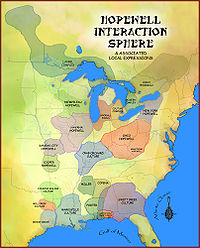
Crab Orchard culture Goodall Focus Havana Hopewell culture Kansas City Hopewell Marksville culture Miller culture Point Peninsula Complex Swift Creek culture Etowah Indian Mounds · Leake Mounds · Kolomoki Mounds Historic Park · Miner's Creek site, · Nacoochee Mound · Swift Creek mound site · Yearwood siteOther Hopewellian peoples Armstrong culture · Copena culture · Fourche Maline culture · Laurel Complex · Saugeen Complex · Old Stone Fort (Tennessee)Exotic trade items Related topics · Ancient Monuments of the Mississippi Valley · Black drink · burial mound · Calumet (pipe) · Effigy mound · Hopewell pottery · Horned Serpent · Eastern Agricultural Complex · Underwater pantherCategories:- Hopewellian peoples
- Mound builders (people)
- Woodland period of North America
- Archaeological cultures of North America
- Great Lakes tribes
- Indigenous peoples of the Northeastern Woodlands
- Indigenous peoples of the Southeastern Woodlands
- Classic period in the Americas
Wikimedia Foundation. 2010.

